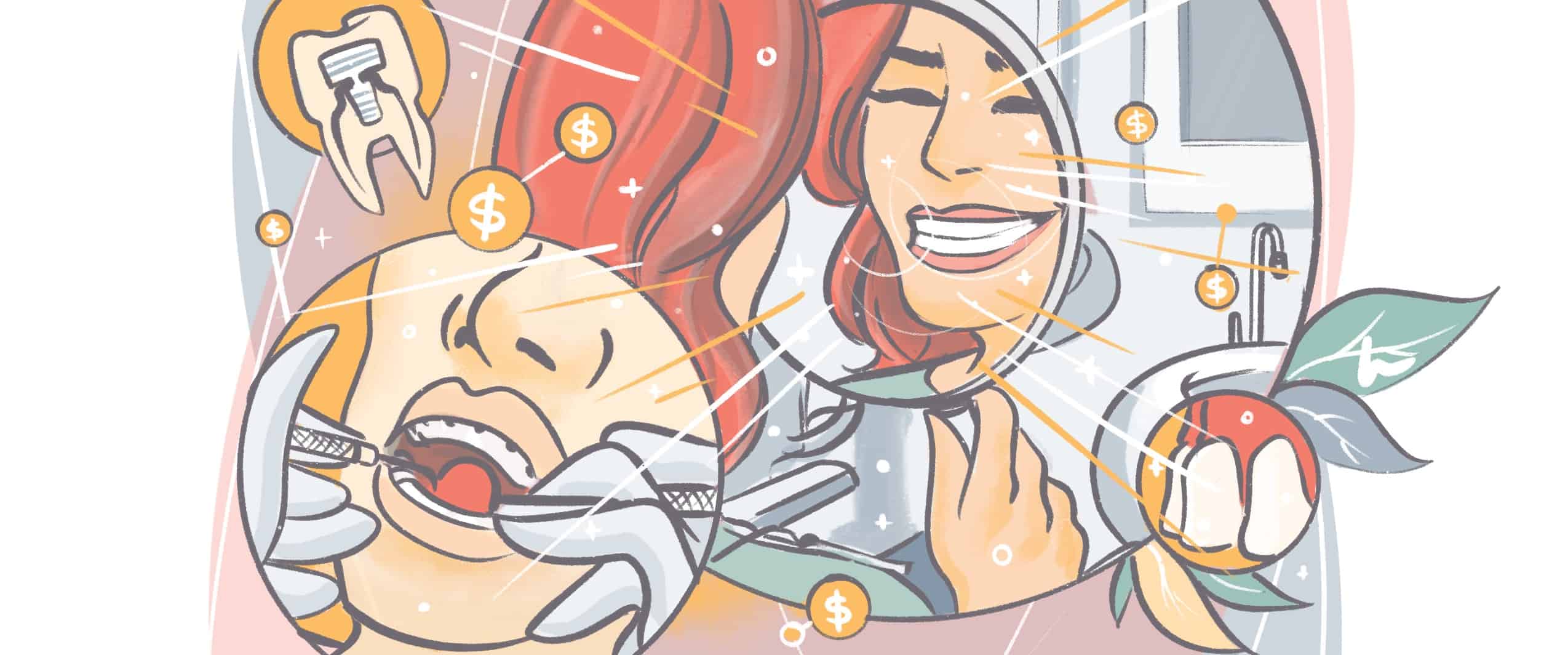Everyone wants a dazzling smile. It makes you look better and feel better about yourself.
But it’s often not enough to follow the American Dental Association’s recommendations. Brushing twice daily, flossing, reducing sugary food intake, and seeing your dentist regularly will help give you clean teeth and good oral health. But if you want really white teeth, be prepared to put in some extra effort. Enter teeth-whitening strips!
What are whitening strips?
Teeth-whitening strips are very thin, nearly-invisible plastic strips, coated on one side with a peroxide-based whitening gel. The gel is typically either hydrogen peroxide or carbamide peroxide.Hydrogen peroxide decomposes faster to release its peroxide, so it’s often used for more rapid effects than carbamide peroxide offers. Regardless, both will achieve the same results.
Strips are meant to be applied onto the teeth with the gel-coated side pressed against the surface of your teeth. This holds them in place while the whitening gel penetrates the surface of the teeth for its whitening effect. You can expect results after daily application, with final, gleaming results in about four weeks.
Do teeth-whitening strips really work?
In a word, yes.
For starters, teeth have a hard outer layer called enamel and an inner layer called dentin. Despite being the inner layer, the dentin determines the color of the tooth, since the enamel is mostly translucent.
The peroxide gel on these strips penetrates the porous enamel to reach the dentin and break down the stains.
Due for a checkup?
Find a top rated dentist near you that takes your insurance.
All this being said, they are effective for whitening, but only to an extent. The grade of peroxide required to whiten teeth significantly isn’t typically safe enough to put on strips.
Are whitening strips bad for you?
Despite their popularity, whitening strips do have some side effects. The issue lies with the same ingredient that does the whitening – peroxide, which can potentially damage teeth over time.
Research presented at the annual American Society for Biochemistry and Molecular Biology shows the hydrogen peroxide used in over-the-counter whitening products can indeed cause damage to teeth, especially to dentin – specifically dentin fibers. This is why teeth often become sensitive (usually temporarily) after you use whitening strips.
Fortunately, this doesn’t mean teeth-whitening strips shouldn’t be used at all. It’s just a matter of finding the right concentration of peroxide for you, cutting back on how often you use them, and simply following the proper instructions.
What are the best whitening strips?
You’ve got loads of options, but here are the most popular ones.
- Crest 3D White Professional Effects Whitestrips – Crest is trusted and well-known in the world of oral wellness, and their strips are probably the most popular for their price point. With between 14 and 30 applications in each box,, the company promises visible whitening that will last for six months.
- Lumineux Oral Essentials Teeth Whitening Strips – This manufacturer claims to use enamel-safe teeth-whitening ingredients to extend below the enamel and remove stains to reveal a white smile.
- Lumist New Advanced Next Generation Teeth Whitening strips – These ones are fast-acting and come with great results. They’re also very good for those of us with sensitive teeth.
- Fairywill Teeth Whitening Strips for Sensitive Teeth – And here’s an excellent option for people with sensitive teeth to reduce stains from coffee, wine, tea, and smoking.
What strength should I get?
Different strips contain different ingredients and varying concentrations of peroxide. It’s best to use one recommended for you by a dentist. (It’s always best to check with your dentist first!) However, here is some general info you should know to help you make the right choice.
Most strips have a peroxide concentration of 6%. Others get up to 14% or more. The higher the concentration, the shorter the time you should leave them on for.
Most strips with a peroxide concentration of 6% are recommended for a 30-minute use two times daily. Those up to 10% should be used for 30 minutes once daily.
Due for a checkup?
Find a top rated dentist near you that takes your insurance.
Other than peroxide concentration, whitener load is another factor to consider. This refers to the thickness of the gel. It’s why a lower peroxide concentration coupled with a higher whitener load can deliver more whitening power than one with a higher peroxide concentration and a lower whitener load. (There’s a mouthful! Pun fully intended.)
To select the best strip for you, check the package for ingredients and their concentrations. Sensitive teeth? Maybe choose the lower-strength ones. Sensitivity not an issue or only have time for one treatment? Maybe try out the stronger ones.
Finally, determine if your teeth stains are extrinsic or intrinsic. Extrinsic stains are on the tooth surface and are typically caused by environmental factors like coffee, red wine, and smoking. Intrinsic stains are usually caused by issues like trauma or medication and they develop deeper within the teeth. Extrinsic stains require lower-strength strips than intrinsic stains.
How do you use whitening strips?
- Choose the proper size for your teeth.
- Read the instructions on the package.
- Don’t brush your teeth before using your strips.
- Pat your teeth dry with a paper towel to remove excess saliva. This will help strips adhere better.
- Peel off the plastic cover of the strip to reveal the adhesive layer.
- Place each strip on your teeth, not your gums.
- Leave it on for as long as the manufacturer recommends.
- Remove and rinse your mouth with water.
- Avoid brushing for at least two hours afterward.
How often should I use whitening strips?
Depending on concentration and the manufacturer’s instructions, most strips should be used twice daily for about two weeks. The resulting whiteness can last up to six months. Don’t use them more than twice a day, because more frequent use doesn’t increase how effective they are. Regardless of the brand, follow the manufacturer’s instructions.
Pros and cons of teeth whitening strips
Pros
- They can deliver pretty fast results
- They’re cheap (relative to professional whitening!) and accessible ‘cause they’re sold over-the-counter
- They can be used at home
Cons
- They can cause tooth sensitivity, which feels pretty bad
- If placed incorrectly, they may give you uneven whitening
What are alternative options to teeth-whitening strips?
- Professional whitening
In-office whitening is probably the fastest way to get whiter teeth. This is because dentists use a higher concentration of peroxide than home treatments allow. Plus, they often use UV or argon laser lights afterward which can produce impressive effects.
- Whitening toothpaste
Unlike strips, whitening toothpastes don’t have much contact with the teeth. Instead, they typically contain special abrasives and chemicals (like peroxide) to break down surface stains like those caused by coffee or smoking.
- Teeth whitening gels
These are clear gels containing peroxide which are applied directly to the surface of the teeth with a brush. Aside from the brush-on gels, some are available as pre-filled trays of gel that you insert in your mouth. You can also try teeth whitening pens.
- Home remedies
Natural whitening remedies can be easy to make and use. Whether or not they all work is another story. But brushing with baking soda works. Coconut oil too, at least to help get rid of recent stains.
Wrap-up
One last thing to note is the cost of teeth-whitening strips. You’ll pay between $20 and $50 for a pack of about 30 strips. And most dental insurance packages don’t cover their cost, since it’s a cosmetic treatment.
Regardless of which option you choose, you should always get a final opinion from your dentist. Set a dentist appointment today to explore your options for whitening teeth. If you don’t have your very own dentist, Opencare can help find a dentist near you.
So all we are saying? Give strips a chance! Just have patience and don’t overuse them to see faster results. With heathy teeth and a whitening routine, you’ll see a brighter smile soon enough. (Your friends might start to find you insufferable with all the smiling you’re gonna do.)
Due for a checkup?
Find a top rated dentist near you that takes your insurance.








